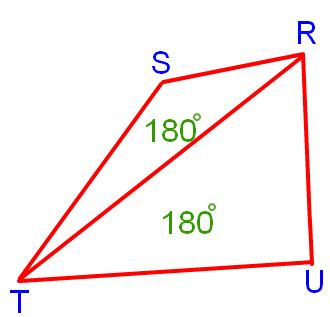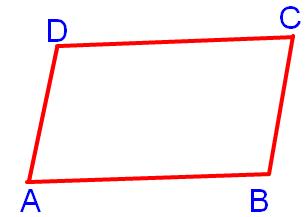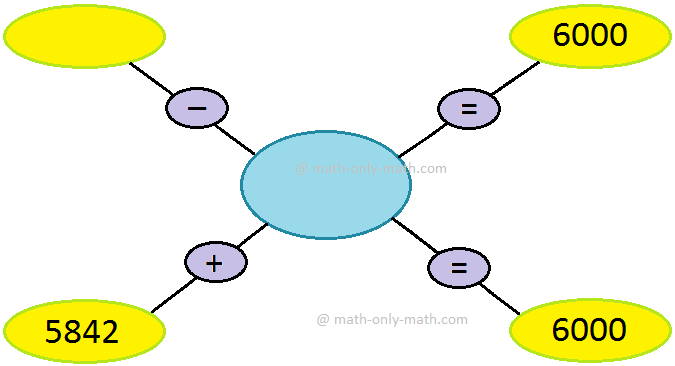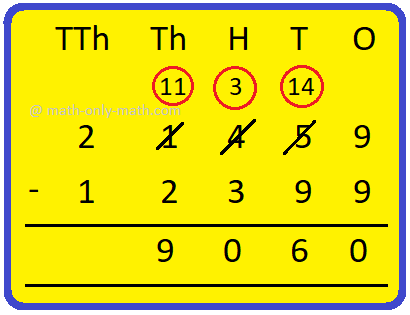Sum of Angles of a Quadrilateral
Sum of angles of a quadrilateral are discussed here. We have now two triangles in the below figure.
We know, the sum of the angles of a triangle = 180°
Since there are two triangles,
therefore, the sum of two triangles is 180° + 180° = 360°
Note: The sum of the four angles is 360°.
For Example:
1. In a quadrilateral ABCD, ∠A = 100°, ∠B = 105° and ∠C = 70°, find ∠D.
Solution:
Here the sum of the four angles
or, ∠A + ∠B + ∠C + ∠D = 360°
We know, ∠A = 100°, ∠B = 105° and ∠C = 70°
or, 100° + 105° + 70° + ∠D = 360°
or, 275° + ∠D = 360°
∠D = 360° - 275°
Therefore, ∠D = 85°
2. Find the measure of the missing angles in a parallelogram, if ∠A = 70°.
Solution:
We know the opposite angles of a parallelogram are equal.
So, ∠C will also measure 70°
Sum of angles = 360°
∠A + ∠B + ∠C + ∠D = 360°
or, 70° + ∠B + 70° + ∠D = 360° (We know, ∠A = ∠C )
or, ∠B + ∠D + 140° = 360°
or, ∠B + ∠D = 360° - 140°
or, ∠B + ∠D = 220°
But ∠B = ∠D (Because opposites angles of a parallelogram are equal)
∠B = ∠D
= 220° ÷ 2
= 110°
Therefore, ∠B = 110°, ∠C = 70° and ∠ D = 110°
Construction of Perpendicular Lines by using a Protractor.
Sum of Angles of a Quadrilateral.
Practice Test on Quadrilaterals.
5th Grade Geometry Page
5th Grade Math Problems
From Sum of Angles of a Quadrilateral to HOME PAGE
Didn't find what you were looking for? Or want to know more information about Math Only Math. Use this Google Search to find what you need.
Recent Articles
-
3rd Grade Subtraction Worksheet | 3-Digit Subtraction Worksheets | Ans
Jan 14, 25 01:20 AM
In 3th Grade Addition Worksheet we will solve how to subtract 3-digit numbers by expansion, subtraction of 3-digit numbers without regrouping, subtraction of 3-digit numbers with regrouping, propertie… -
Facts about Subtraction | Subtraction of Small Numbers|Solved Examples
Jan 14, 25 12:29 AM
The operation to finding the difference between two numbers is called subtraction. Let us know some facts about subtraction which will help us to learn subtraction of large numbers. 1. Subtraction wit… -
Word Problems on Subtraction |Worksheet on Subtraction Word Problems |
Jan 14, 25 12:21 AM
In word problems on subtraction we need to read the question carefully and understand what we need to find out. We know, in subtraction the larger number from which we subtract the other number (the s… -
Worksheet on Estimating Sums and Differences | Find the Estimated Sum
Jan 13, 25 01:34 PM
In 4th grade worksheet on estimating sums and differences, all grade students can practice the questions on estimations.This exercise sheet on estimating sums and differences can be practiced -
Worksheet on Mixed Addition and Subtraction | Questions on Addition
Jan 12, 25 02:14 PM
In worksheet on mixed addition and subtraction the questions involve both addition and subtraction together; all grade students can practice the questions on addition and subtraction together.






New! Comments
Have your say about what you just read! Leave me a comment in the box below. Ask a Question or Answer a Question.